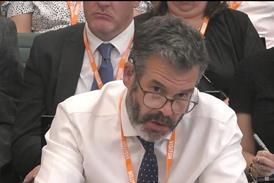Though it is a ‘mere’ 663 pages – rather than the expected 1,000 – there is no getting away from the fact that Lord Justice Jackson’s preliminary report on civil litigation costs is a weighty tome in every respect.
In fact, the 337 pages were sliced off by shrinking the font size and sticking the appendices on a CD, so nothing has been lost anyway.
And to the chagrin of journalists, and probably many lawyers, there is also no executive summary to save ploughing through the thing – which was apparently the point.
So it was no surprise that the little national media coverage that followed focused mainly on his criticism of the government’s policy on court fees – first, because it was one of the few areas of the report where he expressed a firm opinion (it is a preliminary report, after all), and second, because litigation costs and the intricacies of court procedure are not easy to sell to either editors or readers.
Of course, if what Jackson recommends is implemented – which remains a big ‘if’ – it could have a huge impact on civil justice and the many people who use it. Speaking to the Gazette – his only print interview after launching the report – the judge made it clear that radical reform, such as contingency fees, remains firmly on the table ahead of the three-month consultation period.
He insists all this work is worth doing, even though the report finds that 90% of the 2.1 million civil disputes in 2007 were resolved at proportionate cost. ‘There are cases where costs are very high and the costs rules and the Civil Procedure Rules, which result in high costs, merit proper examination.’
The Master of the Rolls, Sir Anthony Clarke, gave him the objective of promoting access to justice at proportionate cost, so what does that mean? If costs exceed damages – which is hardly an infrequent occurrence – is that, by definition, disproportionate?
The broad answer appears to be yes. ‘Where litigation concerns a financial claim, so far as possible, the procedural rules should be structured to enable the litigation to be conducted for a cost which is less than and proportionate to the sum which is in issue. There are occasions where that is impossible to achieve. However, that is the goal towards which I am working.’ He accepts that different considerations apply when the issues at stake are non-financial, such as reputation.
In looking at the costs rules, the impact of some procedural rules cannot be ignored – in fact, Jackson’s impression is that Commercial Court users, for example, ‘wish to retain the present costs rules and to see if the procedures can make the overall cost more economical’. That brings issues such as disclosure, witness statements, expert reports and case management fully into play.
Is this Woolf mark II? ‘I wouldn’t say a new Woolf. I gratefully accept the work done by Lord Woolf in the 1990s and what I am seeking to do is to build upon it... I believe that Lord Woolf would see his report as part of a process of promoting effective civil justice at proportionate cost and it might be said that the exercise upon which I am engaged is another stage of that process.’
Given that, it was no surprise to see his provisional support for extending fixed fees across the fast track, which Woolf proposed in his 1996 report, Access to Justice.
There are almost no sacred cows here – only, almost, because Jackson effectively rules out complete abolition of the cost-shifting rule.
But he sees potential merit in abolishing it in discrete areas, particularly group actions, or introducing one-way costs-shifting in personal injury (PI) so that an unsuccessful claimant would not have to pay the defendant’s costs. Of interest is that costs-shifting does not have to just mean ‘loser pays’, says the report. ‘Other options which are more directly based on encouraging earlier and appropriate resolution of claims, including ADR, may well be worthy of further consideration.’
After-the-event insurers will view the idea of one-way costs-shifting in PI with huge alarm, which was probably the same reaction of the Association of Personal Injury Lawyers to Jackson’s ‘tentative suggestion’ – in the context of whether to raise the small claims limit for PI cases – that insurers which admit liability would agree to treat the claimant as their own insured. This is an idea floated a few years ago by Lord Phillips, but rests on the assumption that insurers can be trusted to deal fairly with claimants.
Other sacred cows under scrutiny include the (relatively new) principle that PI claimants should not suffer any deductions from damages to cover costs, and therefore whether to turn back the clock on recoverability of success fees and ATE premiums, the government policy that precipitated the costs war and ultimately, it could be argued, this review.
The report says it may be arguable that the recoverability of success fees and premiums has allowed litigation to move ‘too far away from considerations of proportionality’. Could the era of risk-free litigation be on the way out, then? ‘I may be persuaded that risk-free litigation should be continued,’ he says, ‘but I do see it as a problem.’
Nobody can envy the task given to him. As he notes in the first chapter of his report: ‘Whatever I may recommend at the end of this year (and at this stage I still have an open mind), one thing is inevitable. My final report will generate protest from at least some directions and quite possibly from all directions.’
Neil Rose is a freelance journalist and editor of Litigation Funding



























No comments yet